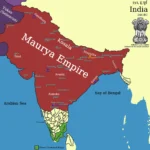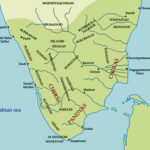I. Native Successors of Mauryas
Sunga Dynasty : 185 BC – 73 BC [Capital-Vidisha (M.P.)]
>> Sunga Dynasty was established by Pushymitra Sunga, a Brahmin Commander-in-Chief of last Mauryan ruler named Brihadratha in 185 BC.
>> Pushyamitra was a staunch adherent of orthodox Hinduism. However, the great Buddhist stupa at Bharhut (in M.P.) was built during the reign of Sungas.
>> Pushyamitra was succeeded by his son Agnimitra, the hero of Kalidasa’s drama‘ Malvikagnimitra.
>After Agnimitra, a series of weak rulers such as Vasumitra, Vajramitra, Bhagabhadra, Devabhuti, followed, leading to the decline of the dynasty.
>> Patanjali, author of the ‘Mahabhasya’, was born at Gonarda in Central India. Patanjali was the priest of 2 Avamedha Yajnas, performed by Pushymitra Sunga.
Kanva Dynasty: 73 BC – 28 BC [Capital- Patliputra]
>> In 73 BC, Devabhuti, the last ruler of the Sunga dynasty, was murdered by his minister Vasudeva, who usurped the throne and founded the Kanva dynasty.
>> The period of Kanva rule came to an end in 28 BC.
Satavahana Dynasty: 60 BC – 225 AD [Capital – Pratishtana/Paithan (Maharashtra)]
>> The most important of the native successors of the Mauryas in the Deccan and Central India were the Satvahanas.
>> Simuka (60 BC-37 BC) was the founder of the Satvahana dynasty.
>> Satakarni I, its 3rd ruler, raised its power and prestige by conquests.
>> Hala, its 17th ruler, was the author of ‘Gathasaptasati’ or, ‘Sattasai’ in Prakrit. Gunadhya, the author of ‘Vrihat Katha’ (in Prakrit), was the contemporary of Hala.
>> It was Gautamiputra Satakarni (106 – 130 AD) who revived the Satavahana power and defeated the Saka Ksatrap Nahapana. He was the greatest Satavahan ruler (23rd Satavahana ruler).
>> Vasishthiputra Sri Satakarni, its 24th ruler, was married to the daughter of Saka Kstrapa Rudradaman, but defeated by him twice.
>> Yajna Sri Satakarni, its 27th ruler, was the dynasty’s last great ruler.
>> Pulamavi III, its 30th ruler, was the last Satavahana ruler.
>> Satavahanas were finally succeeded by the Ikshvakus in 3rd Century AD.
>> Stupas (large round structure erected over a sacred relic) were seen scattered all around Ellora. The most famous of these attributed to the Satavahana period are Amravati, a sculptural treasure house, and Nagarjunakonda.
>> The official language of the Satavahanas was Prakrit
The Satavahanas issued their coins in lead (mainly), copper, bronze and potin.
Il. Foreign Successors of Mauryas
The Indo-Greeks: 2nd Century BC
>> Indo-Greeks (Bacterian Greeks) were the first foreign rulers of North-Western India in the Post-Maurya period.
>> The most famous Indo-Greek ruler was Menander (165 BC-145 BC), also known as Milinda. He was converted to Buddhism by Nagasena or Nagarjuna.
>> They were the first to issue gold coins.
>> They introduced Hellenic i.e. Greek features in art giving rise to Gandhar school in the North-Western India.
The Sakas: 1st Century BC-4th Century AD
>> The Sakas, also known as Scythians, replaced the Indo-Greeks in India.
>> The most famous Saka ruler in India was Rudradaman (130 AD-150 AD). He is famous not only for his military conquests (particularly against the Satavahanas) but also for his public works (he repaired the famous Sudarsan lake of the Mauryan period) and his patronage of Sanskrit (he issued the first-ever long inscription in chaste Sanskrit).
>> In about 58 BC a king of Ujjain – Vikramaditya – is supposed to have fought effectively against the Sakas. An era called Vikrama Samvat is recknoed from 58 BC.
The Parthians: 1st Century BC-1st Century AD
>> Originally the Parthians (Pahlavas) lived in Iran, they replaced the Sakas in North-Western India, but controlled an area much smaller than the Sakas.
>> The most famous Parthian king was Gondaphernes in whose reign St. Thomas is said to have come to India for the propagation of Christianity.
The Kushans: 1st Century AD-3rd Century AD
>>The Kushans replaced the Parthians in North-Western India and then expanded to the lower Indus basin and the upper and middle Gangetic basin.
>> The first Kushan dynasty was founded by Kadphises I/ Kujul Kadhphises. The second king was Kadphises II/ Vema Kadphises who issued gold coins.
>> The second Kushan dynasty was founded by Kanishka. Its kings extended the Kushan power over upper India. Their capitals were at Peshawar (Purushapura) and Mathura.
>> The most famous Kushan ruler was Kanishka (78 AD – 101 AD), also known as ‘Second Ashoka’. He started an era in 78 AD which is now known as the Saka era and is used by the Government of India.
>> Kanishka was a great patron of Mahayana Buddhism. In his reign 4th Buddhist council was held in Kundalavana, Kashmir where the doctrines of the Mahayana form of Buddhism were finalised.
>> The last great Kushan ruler was Vasudeva I.
>> The Kushans controlled famous silk route starting from China, passing through their empire on to Iran and Western Asia. This route was a source of great income to the Kushans.
>> The Kushans were the first rulers in India to issue gold coins on a wide scale.
>> In the royal court of Kanishka a host of scholars found patronage. Parsva, Vasumitra, Asvaghosha, Nagarjuna, Charak and Mathara were some of them.
>> In 46-47 AD, Hippalus, a greek sailor, discovered the monsoon sea-route to India from West Asia.
>> Important ports: Barygaza (Bharoch) and Barbairicum (Western Coast); Aricamedu (Podeku-according to ‘Periplus’)-near Pandicheri-Eastern Coast.
Featured Image Courtesy: wikipedia



